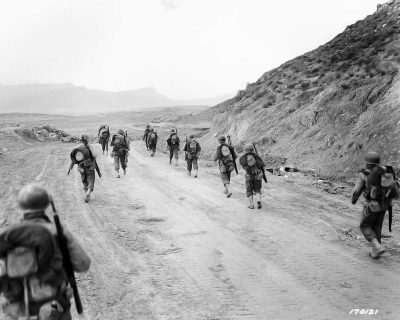FOW: Firestorm Tunisia – Terrain
By Scott Grasse
Editor’s Note: No Dice No Glory is pleased to host a global Flames of War V4 campaign designed by Scott Grasse. Follow along, post your results, check for the latest updates on
Pre Campaign Battles to get you started,
The terrain in Tunisia is rugged, unique, and had a major influence on the battles fought there. Several new terrain features are introduced for Firestorm Tunisia. Get ready to encounter vast Salt Beds otherwise known as tank death traps; Rocky Ground that makes it impossible to dig in; Heavy Scrub that is perfect for hiding an ambush; and entrenched, dry water-ways called Wadis that form a natural and formidable defense. Heavy spring rains would then transform these difficult terrains to nearly impassable.
Some of the more intriguing (but rare) features encountered in Tunisia are ancient Roman sites and ruins. This is a great chance to field your Roman walls, columns, and crumbling foundations. Use them as terrain, objectives, or simply eye candy. The unofficial campaign challenge (i.e., win for bragging rights) is to come up with the best Roman ruins for your table. So break out those ancients.
There are three main geographic regions in Firestorm Tunisia – Rugged, Coastal Plain, and Desert. You use the terrain type on the Campaign Map where your battle is being played then consult the Terrain Tables below to guide the setup of your battle table. You can use them as rigidly or as loosely as you like, but a great part of the experience is recreating the challenging terrain that played a major part in the outcomes of these battles.
You can download the tables AND a nifty summary table for all the terrain used in the campaign at:
Rugged
High density of rocky hills, escarpments, gentle hills and low rises. Roll a die to determine the number of elevated terrain features:
1-2: Very rugged; two-thirds of the table should include elevated terrain (around 5-7 features);
2-4: rugged; about half the table should include elevated terrain features (around 3-5 large features);
5-6: valley; roughly one third or less of the table should include elevated terrain (around 1-3 features).
• Roll a die: On a 1-3 a Wadi is present.
• Roll a die to determine flat areas: 1-3: Soft Sand; 4-6: Rocky Ground.
• Add patches of soft sand/rocky ground, open scrub and/or heavy scrub. Include roads, railway embankment, palm groves and/or buildings for variety.
• Crop fields and orchards may be present especially in less-rugged terrain.
Coastal
Open areas are periodically broken by low rises and gentle hills.
• Roll a die: On a 1-3 a Wadi is present.
• Roll a die to determine flat areas: 1-3: Firm Sand; 4-6: Soft Sand;
• Crop fields and orchards are common.
• May contain large areas of salt beds, marsh or swamp.
• Add patches of soft sand/rocky ground, open scrub and/or heavy scrub. Include roads, railway embankment, palm groves and/or buildings for variety.
Desert
Mostly open ground with a small amount of either escarpment, low rises, gentle hills, or steep dunes.
• Gabes and Mareth sectors have a Wadi. Otherwise, roll a die: On a 1-3 a Wadi is present.
• Roll a die to determine flat areas: 1-2: Firm Sand; 3-5: Soft Sand; 6: Rocky Ground
• Add patches of soft sand/rocky ground, open scrub and/or heavy scrub. Include roads, railway embankment palm groves and/or buildings for variety.
Roman Ruins
Ancient Roman sites and rare ruins could be found as part of the battlefields of Tunisia. Feel free to use them for an added element of intrigue. Assign a terrain height and bulletproof cover that makes sense based on the models you field.
Terrain Explanation
* Escarpments are Steep Hills with High Embankment along one or more sides.
* Heavy Scrub is treated as woods.
* Marsh is a treated as Open Scrub and Soft Ground.
* Rocky Ground is treated as Soft Ground.
* Railway Embankments are treated as Low Embankment.
* Salt Flat is treated as Soft Ground.
* Steep Dune is treated as Steep Hill
* Wadi is a rocky, dry watercourse that floods in rainstorms. Wadis are 4-8” wide and must meet the table edge at one or two sides. A Wadi will have 1 to 3 crossings of soft sand. Road crossings will always be soft sand. Wadi floors are Rocky Ground. Wadi sides are treated as Gully Side. A team capable of gapping an anti-tank ditch may also attempt to gap a wadi. If successful the gap creates a 2” wide path across the Wadi of soft sand
* All other terrain types are described on p. 43 of the MW rulebook.

